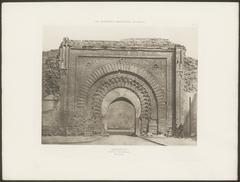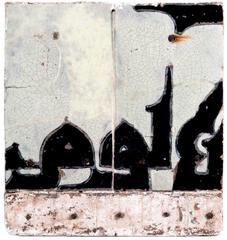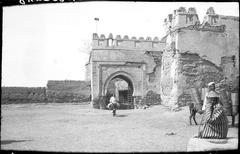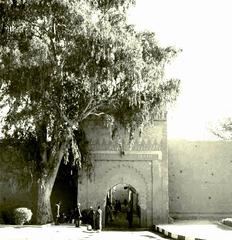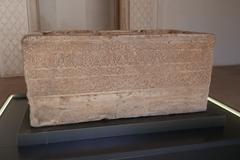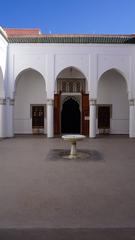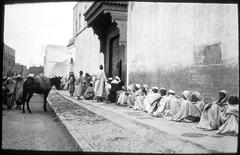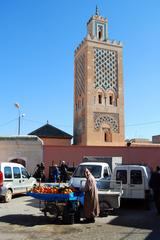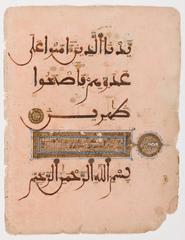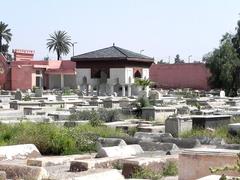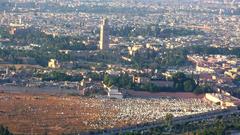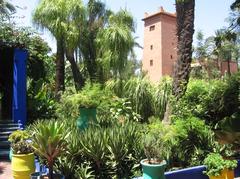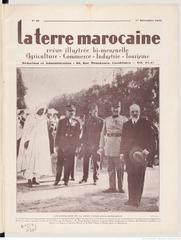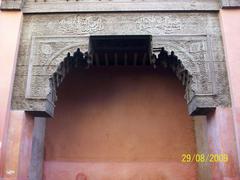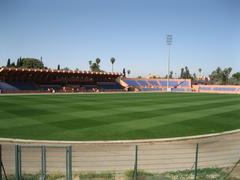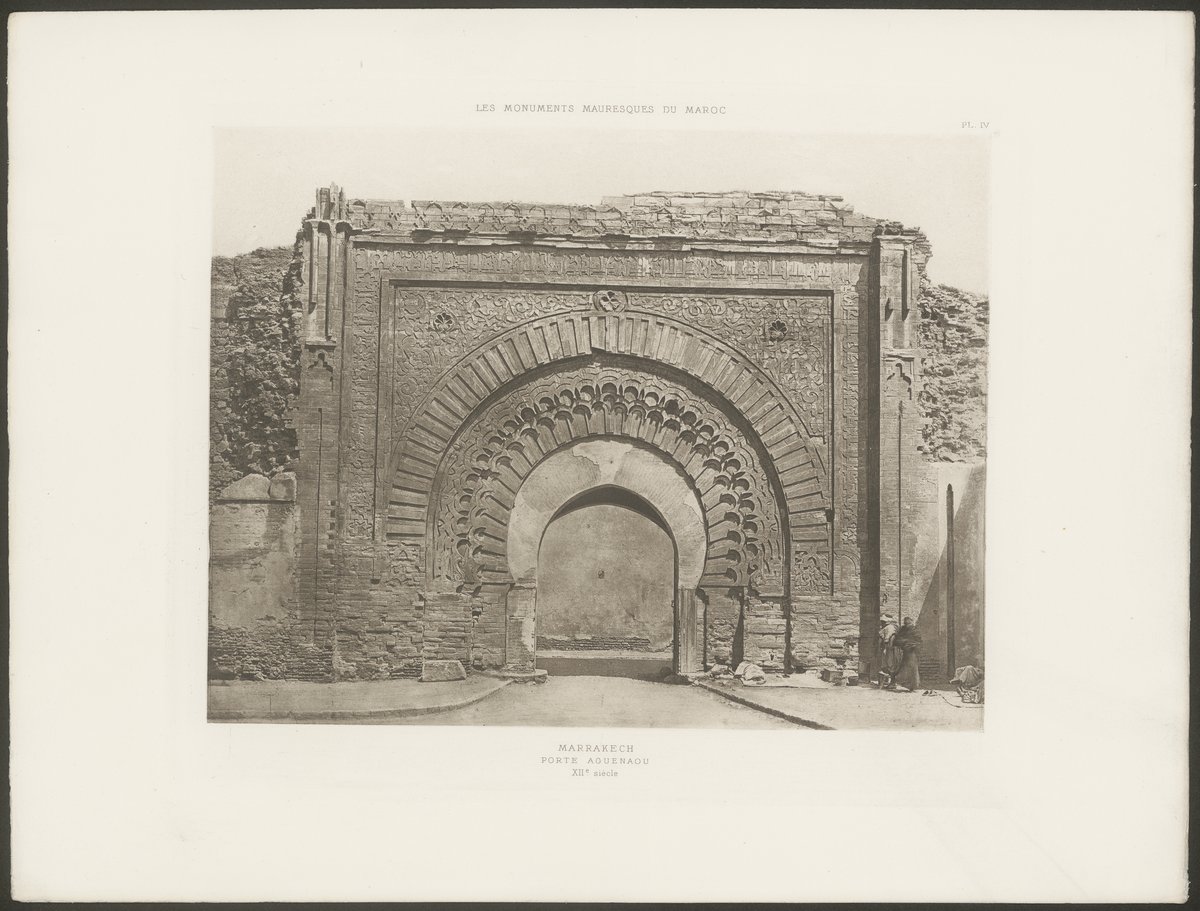
Bab Agnaou Marrakesh: Visiting Hours, Tickets, and Comprehensive Travel Guide
Date: 14/06/2025
Introduction
Bab Agnaou is one of Marrakesh’s most iconic historical monuments, famed for its striking Almohad architecture and deep cultural significance. Constructed in the late 12th century as the ceremonial gateway to the royal Kasbah, the gate stands as a testament to Morocco’s medieval grandeur and artistic innovation. This guide provides an in-depth look at Bab Agnaou’s origins, architectural features, historical context, visitor information, accessibility, nearby attractions, and practical travel tips—offering everything you need to plan an enriching visit.
1. Historical Background and Origins
Bab Agnaou was built between 1188 and 1190 CE during the reign of Almohad Caliph Abu Yusuf Ya’qub al-Mansur, as part of a major expansion of Marrakesh’s fortified walls (Daily Sabah). The Almohads, a powerful Berber dynasty, established the city as their imperial capital, overseeing a flourishing of architecture and culture (Al Ksar). Unlike purely defensive gates, Bab Agnaou was designed as a majestic ceremonial entrance to the royal Kasbah—the seat of sultans, their courts, and state administration.
The gate’s name has several proposed origins: it may derive from the Berber word “gnaoua,” referring to sub-Saharan peoples who entered Marrakesh via this gate, or from “deaf” or “mute,” possibly alluding to the gate’s original lack of defensive towers (Al Ksar; Moroccan Vacations).
2. Architectural Features and Symbolism
Construction and Materials
Bab Agnaou is constructed primarily from blue-grey sandstone quarried in the Gueliz region, distinguishing it from the red clay and brick typical of Marrakesh’s other gates (Al Ksar; Atlas Obscura). Over centuries, the stone has weathered to a reddish hue, harmonizing with the city’s famed red walls.
Facade and Ornamentation
The gate is best known for its monumental horseshoe arch, set within a rectangular frame and accentuated by four concentric, semi-circular arches. These arches are decorated with alternating geometric and floral bands, sunburst patterns, and intricate Almohad motifs. The spandrels and upper sections feature elaborate stonework, including stylized palmettes and eight-pointed stars—symbols of unity, power, and divine protection (Al Ksar; Moroccan Vacations).
Kufic Calligraphy
A prominent frieze of angular Kufic script runs across the facade, inscribed with Quranic verses such as “Enter with blessing, serene people,” reinforcing both religious and royal authority (Atlas Obscura).
Defensive and Ceremonial Roles
Originally, Bab Agnaou was flanked by towers and heavy wooden doors, but its primary function was ceremonial rather than military. It served as the entrance for dignitaries, officials, and royal processions, underlining the sultan’s power and the exclusivity of the Kasbah (Egypt Tours Plus).
3. Role in Marrakesh’s Urban and Royal Life
The Kasbah district, accessed through Bab Agnaou, encompasses the royal palace, Saadian Tombs, El Badi Palace, and Kasbah Mosque. The gate’s location on the southern edge of the medina marked the transition from the public city to the private royal enclave (Orana Travel). Bab Agnaou also played a role in public proclamations and state ceremonies, forming a vital part of Marrakesh’s historical landscape.
4. Conservation and Modern Context
Bab Agnaou has undergone several restorations to preserve its delicate stonework from weathering and pollution (Atlas Obscura). Today, it remains a living monument, often topped by stork nests and flanked by symbolic cannons. Its grandeur continues to inspire visitors, scholars, and photographers alike.
5. Visiting Bab Agnaou: Hours, Tickets, and Accessibility
- Visiting Hours: Bab Agnaou is an open-air monument with 24/7 public access. There are no restricted hours, but visiting during daylight (morning or late afternoon) is ideal for viewing details and photography.
- Entry Fee: There is no entrance fee or ticket required to visit Bab Agnaou. It is freely accessible to all.
- Accessibility: The immediate area is flat and accessible on foot, though the surrounding medina features cobblestone streets which may be challenging for wheelchair users. Some nearby attractions offer limited accessibility.
- Location: Situated in the southern medina, Bab Agnaou is a 15-minute walk from Djemaa el Fna and close to the city’s main transport connections (Orana Travel).
6. Practical Travel Tips
- Best Time to Visit: Early mornings and late afternoons provide optimal lighting and fewer crowds. Spring (March–May) and autumn (September–November) offer the most comfortable weather.
- Dress Code: Modest clothing is recommended out of respect for local customs.
- Photography: The gate is a renowned photography spot. Tripods are generally permitted, but be mindful of pedestrian traffic.
- Safety: The area is safe and well-patrolled, though visitors should remain cautious of pickpockets in crowded places.
- Amenities: No dedicated restrooms or ticket offices are available at the site, but cafés, restaurants, and shops are nearby.
7. Nearby Attractions
Bab Agnaou serves as a gateway to Marrakesh’s royal quarter, with several must-visit sites within walking distance:
- Saadian Tombs: Ornate royal burial grounds from the 16th century.
- El Badi Palace: Ruins of a grand 16th-century palace, open with an entry fee.
- Kasbah Mosque: Known for its minaret; not open to non-Muslims.
- Royal Palace: Impressive from outside, though not open to the public. (Orana Travel; Wikipedia)
8. Cultural Experiences and Guided Tours
Guided tours of the medina frequently include Bab Agnaou, providing historical context and architectural insights. Local guides can be booked through hotels or reputable operators.
The gate and its surrounding Kasbah sometimes host cultural events and festivals—check local event listings or tourist information centers for details.
9. Frequently Asked Questions (FAQ)
Q: What are Bab Agnaou’s opening hours?
A: Bab Agnaou is open 24/7, with no restricted visiting hours.
Q: Is there an entrance fee?
A: No, the gate is free to visit.
Q: Are guided tours available?
A: Yes, many local tour operators include Bab Agnaou in their itineraries.
Q: Is Bab Agnaou wheelchair accessible?
A: The immediate area is accessible, but cobblestone streets nearby may pose challenges.
Q: Can I take photos at Bab Agnaou?
A: Yes, photography is allowed and encouraged.
10. Suggested Visuals
- Photographs: High-resolution images of Bab Agnaou’s facade and intricate details (alt tags: “Bab Agnaou Marrakesh historic Kasbah gate”).
- Maps: Interactive maps showing Bab Agnaou’s location in the medina and proximity to other attractions.
11. Additional Resources and Related Guides
For further exploration, check out:
For up-to-date travel tips and guided tours, download the Audiala app and follow us on social media for the latest updates.
12. Summary and Final Recommendations
Bab Agnaou remains a majestic testament to the Almohad era, combining monumental architecture, intricate artistry, and enduring cultural significance. Its open access and proximity to Marrakesh’s top historical sites make it a must-visit landmark for travelers seeking to immerse themselves in the city’s imperial heritage. For an optimal experience, time your visit during cooler hours, explore nearby attractions, and consider joining a guided tour to gain a deeper appreciation of Marrakesh’s rich past.
